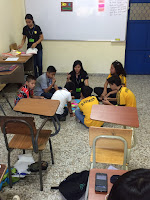 Hello, everybody welcome to my teaching practicum blog.
My name is Fatima Arias, I am twenty years old and I am studying teaching at
Don Bosco University. This is the second practicum that I am taking, the first
practicum that I took was with kids and all that I can say is that it was an unforgettable
experience because I learned many things that I did not know before but now it
is time to practice and put all my knowledge and skills to work by teaching
English to teenagers. I feel excited and with a lot of expectations about this
new experience because I am sure I will learn many things and, all the knowledge
that acquire will be useful for me as a future teacher.
Hello, everybody welcome to my teaching practicum blog.
My name is Fatima Arias, I am twenty years old and I am studying teaching at
Don Bosco University. This is the second practicum that I am taking, the first
practicum that I took was with kids and all that I can say is that it was an unforgettable
experience because I learned many things that I did not know before but now it
is time to practice and put all my knowledge and skills to work by teaching
English to teenagers. I feel excited and with a lot of expectations about this
new experience because I am sure I will learn many things and, all the knowledge
that acquire will be useful for me as a future teacher.miércoles, 17 de agosto de 2016
 Hello, everybody welcome to my teaching practicum blog.
My name is Fatima Arias, I am twenty years old and I am studying teaching at
Don Bosco University. This is the second practicum that I am taking, the first
practicum that I took was with kids and all that I can say is that it was an unforgettable
experience because I learned many things that I did not know before but now it
is time to practice and put all my knowledge and skills to work by teaching
English to teenagers. I feel excited and with a lot of expectations about this
new experience because I am sure I will learn many things and, all the knowledge
that acquire will be useful for me as a future teacher.
Hello, everybody welcome to my teaching practicum blog.
My name is Fatima Arias, I am twenty years old and I am studying teaching at
Don Bosco University. This is the second practicum that I am taking, the first
practicum that I took was with kids and all that I can say is that it was an unforgettable
experience because I learned many things that I did not know before but now it
is time to practice and put all my knowledge and skills to work by teaching
English to teenagers. I feel excited and with a lot of expectations about this
new experience because I am sure I will learn many things and, all the knowledge
that acquire will be useful for me as a future teacher.
cognitive Development in Teenagers
What I knew
What I knew about cognitive development is that at this stage teenagers can solve more complex problems. Also, the ability to reason is increasing, and they consider different opinions and points of view.
After reading
After reading information about this topic, I can define this process as the capacity to think and reason in a complex way by reflecting on the way teenagers make decisions.
According to the book “Human Development” there are two ways of thinking:
Concrete operations: this process is called this because children (6 to 12 years old) can think concretely and what they are thinking about it is physically present (e.g. subtract or divided).
The second thinking process is called formal operations by this time adolescence can develop more complex thinking, including abstract thinking, they can create new ideas or make questions and they can consider different points of view according to the criteria they have.
Something that called my attention while reading this article is that some indicators are indicating a progression from simple to more complex thinking development, and these indicators are the following:
Early adolescence: complex thinking is focused on school and home environments.
Middle adolescence: complex thinking is focused on futuristic plans for different possibilities.
Late adolescence: complex thinking is focused on personal decisions, idealistic views on specific topics also, is focused on making career decisions.
Conclusion.
During this process, there are really important changes happening in the teenager’s brain but the intellectual capacity is increasing and they can solve more complex problems so as a future teacher, I can put my students to work in solving a complex task with logical thinking but, of course, I need to be aware of the attention span because with many changes happening in the brain their attention span can be shorted. So for that, I need to look for interesting tasks or topics that called the attention of my students we do not have to work only with worksheets because that could be so boring for students.

